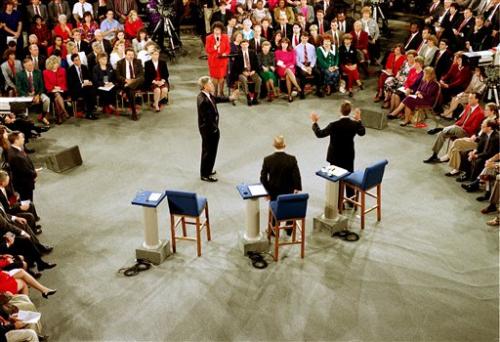Maybe Greta Thunberg, the 16-year-old climate activist who gained attention with her “school strike for climate” outside Swedish parliament last year, will finally be the one to sound the alarm on the rocketing rate of climate change, and the dire need and diminishing window for action on it. The ‘big 3’ broadcast networks, ABC, CBS & NBC, certainly aren’t doing it.

www.spiked-online.com
Thunberg, fearless and becoming ever more prominent, unabashedly rebuked ~200 attendees at the COP24 Climate Conference in Poland last December for their subpar record on global warming.
“You say you love your children above all else, and yet you are stealing their future in front of their very eyes. You only talk about moving forward with the same bad ideas that got us into this mess, even when the only sensible thing to do is pull the emergency brake. You are not mature enough to tell it like it is,” she said.
At Davos this year she told billionaire entrepreneurs and global leaders: ~“According to the IPCC, we are less than 12 years away from not being able to undo our mistakes. Adults keep saying: ‘We owe it to the young people to give them hope.’ But I don’t want your hope. I want you to panic. I want you to feel the fear I feel every day. And then I want you to act as if the house is on fire, because it is.”
Davos speech: speaking truth to power (watch it!)
Even with all the media attention she is getting, it hasn’t done the broadcast network’s nightly news viewers any good, there’s been nary a mention of her on their newscasts—sadly unsurprising, given the pittance of climate reporting by them, in general. “On climate change, we have failed, … and the media has failed to create broad public awareness,” she admonished them.
Five years ago, I took a look at the big 3’s reporting on global warming solutions on those news shows for the preceding 5 years. It wasn’t good. From July 2009 – July 2014, searching TV News Archive I found 0 reports on “taxing carbon” and “carbon sequestration”, and 1 report (CBS) on “cap and trade”. Within a smaller 1.5 year window (2013 – July 2014), and searching more general terms (“carbon emissions”, “greenhouse gases”, “global warming” & “climate change”), I got 4-6 hits of any substance, for each of the 3 networks.
Now, 5 years later, assessing their record again for the 5 years prior, it is little improved. Aside from “Paris Climate Agreement”, the number of news segments for all other ‘climate solution’ search terms, combined, maxed out at 6 for CBS (only 1 in-depth), with 3 each for ABC (all minor refs), and NBC (2 in-depth). (See [intlink id=”2099″ type=”page” anchor=”Clim_Sol_Data_2014-19″]Climate Solutions Data[/intlink], and Search Terms List & TV News Archive Notes, below.)
In their coverage of the “Paris Climate Agreement”, the networks followed expected patterns, each with clusters of reports around the 2015 PCA negotiations & signing (terms, adequacy) and 2017 Trump pullout (jobs, fallout out from leaders & CEO’s) events, with a smattering of PCA references throughout the period, each varying from the others in number and degree. For in-depth reports, the tally was: ABC–1, NBC–2, CBS–4, with a mix of climate-related stories linked in, such as: coal vs. renewables jobs (ABC & NBC), Norway’s climate success with subsidies and incentives (CBS), Glacier National Park’s diminished 26 out of 150 glaciers remaining (NBC), and the cost of extreme weather (CBS).
Good, where it was, but not all that one would hope for.
Actually, rather abysmal given the acceleration of shocking reports on the environment that seem to come flying at us, almost nonstop, from print media. From recent readings of 84o F arctic temps, and 415 parts/million carbon levels (the highest in human history, and rising, with ~1,300 tons of carbon dioxide/second spewing into the air from fossil fuels, which still comprise 81% of the world’s energy use), to the staggering implications of the 25-years long and, until recently, underestimated by 60%(!) warming of oceans (90% of trapped atmospheric energy is absorbed–8 times the annual global energy consumption), to the “18 of the 19 warmest years on record occurring since 2000” stat–the hits just keep on coming.
Against that steady drumbeat of bad news, a parade of equally unrelenting climate policy reversals continues to issue forth from the Trump Administration, adding insult to injury, as in some hideously demented comic parody, run amok. The latest reversals include: rolling back of emissions rules for coal plants, relaxation of automobile mileage standards, and the easing of rules for oil and gas leaks, to name a few. The New York Times just reported a tally of 49 rollbacks, completed, with 34 more in progress, for a total of 83.
I have pledged to keep this site bias and snark free, but the above scenario couldn’t help but conjure up another standoff in nature I recently encountered while hiking.
 Turkeys vs. deer; looks like the turkeys are winning.
Turkeys vs. deer; looks like the turkeys are winning.
In January of this year, the Energy Innovation and Carbon Dividend Act (HR 763) was introduced in the House. The bipartisan bill (D-58, R-1) is geared to “reduce greenhouse gas emissions with a steadily rising fee on fossil fuels” and is backed by 3,500 U.S. economists, including Nobel laureates, former presidential advisers and Federal Reserve chairs. ~“A carbon tax offers the most cost-effective way to reduce carbon emissions at the scale and speed necessary, and will harness the marketplace to steer us toward a low-carbon future,” they declared in a joint statement. In his Op-Ed reporting this, Jonathan Marshall, of Citizens Climate Lobby (CCL), touts the benefits of the bill–90% emissions reduction by 2050, creation of ~2.1M jobs, GDP growth (citing Sweden’s 60%), and even cost-compensation in the form of monthly dividends to the public.
Monthly dividends to the public. What a deal! Now, if we could only get the TV news media to report on it. Thus far, it has turned up on just CSPAN, and FOX News (in a 5-minute discussion with Mark Reynolds of CCL; see Featured Video, bottom, Home page).
Will shaming the major networks to report on climate solutions make any difference, even if they do relent?
The NYT’s David Leonhardt gives his view on why promoting climate solutions using technical terms (e.g. “carbon tax”) instead of human benefit terms (e.g. “cleaner energy”, “better health”) fails, citing examples and outcomes for each approach. The ‘human connection’, and anecdotes of its political benefits have become ubiquitous to the point of broad acceptance in recent years and, for sure, there is merit to it. But couching issues strictly in human terms falls short and can never preclude the need for straight-up, dispassionate and accurate information, consistently delivered. To argue so is a false choice and one that subordinates rational thinking, a distinguishing characteristic of humans, to emotion–a devolutionary proposition, to be sure.
Fortunately for us, an unnecessary one, as well. For just as people aspire to make a human connection and ‘do the right thing morally’, so do they seek edification through knowledge. They just don’t like having ‘answers’ and ‘solutions’ rammed down their throat. It is because of this distinction that I believe in the goal of ATD–the widespread dissemination, across the board, of a higher level of reporting, directed, in part, by the public themselves. Further, I would say, putting tools in the hands of people to direct their own edification is the human connection. It empowers them by increasing their personal stake in Democracy, and fosters engagement, both with the media and their fellow citizens.
Since my last 5-year survey, both the broadcast and cable networks’ nightly news viewerships have grown to 23.75M (average, ABC, CBS & NBC, combined) and 4.76M (average, CNN, MSNBC & FOX News, combined), respectively. (See PEW 2016 data.) Though cable’s viewership grew faster than the broadcast networks’, the networks still get, on average, ~5 times more eyeballs than cable, per night. When you consider that elections are won or lost by margins that are far smaller than the networks nightly viewership (9.5M for Obama in 2008, the biggest win going back 8 elections, vs. 23.75M network viewership), the case can be made that broadcast network reporting could have significant impact on voters (though causality cannot be proven, either way; nor is this an apples to apples comparison).
For myself, my bias and snark breach and the fact that I identify as Democrat, notwithstanding, I simply see the world as one that is governed by the real-life forces that govern it, and not by ideology. So, I just simply always want to know what the facts of issues are. All of them. And all of the time. And if we all come into better and more regular possession of those facts, we can launch our debates from an even playing field and, then, really begin to solve problems.
Here are my Rule break calls for the media.
- ABC, CBS & NBC: Cover the Topic of carbon tax–it’s time!
All news media: Ask the Questions:
- What are the methods and costs of putting a price on carbon?
- What are the methods and costs of removing carbon from the atmosphere?
- What is the cost of failing to meet the PCA goal of 1.5o temp raise?
Oh, and thank you, Greta.
Search Terms List:
(Notes: Multiple permutations of search terms were used, as warranted. Also, the need for quotes is deceiving since ‘hits’ occurred if any of the main terms within quotes were found in a TV newscast, not just the full quote.)
- “carbon tax”, ”tax on carbon”, ”taxing carbon”, ”price on carbon”, ”carbon surcharge”, ”price on emissions”, ”emissions tax”
- “fossil fuels fee”, “fossil-fuels fee”, “fee on fossil fuels”
- “Energy Innovation and Carbon Dividend Act”
- “H.R. 763”, “HR 763”, “HR-763”, “HR bill 763”
- “Green New Deal”
- “Intergovernmental Panel on Climate Change”, “IPCC”
- “Paris Climate Agreement”
- “United States Climate Alliance”
- “U.S. Climate Alliance”
- “Greta Thunberg”
TV News Archive Notes:
I noticed, anecdotally, the closed caption text that is used for searches has more gaps than it seemed to 5 years ago. From experience, however, overall patterns emerge to tell the story and I believe there is value in this tool. See other [intlink id=”1347″ type=”page” anchor=”TVNewsArch_CCGaps”]TV News Archive Notes[/intlink] on my contact with archive.org on this subject.
Additional Links – Articles that give (what I consider to be) a ‘full’ picture of the topic, representing opposing opinions & data fairly.
Scientific American: 2019 U.S. Power-Sector Trends –> Rise in Emissions
New York Times: EPA Finalizes Coal Rules Rollback
New York Times: Problem with Carbon Tax
Bloomberg: Half World’s Power from Wind, Solar by 2050

